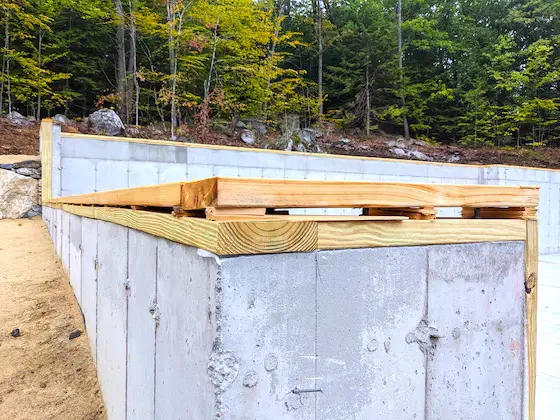Bad New Home Builder

How many mistakes do you see in this photo? I count over four. Keep reading below! Copyright 2022 Tim Carter
Bad New Home Builder - On My Own Street!
Over the past five months I’ve watched the dream of a neighbor I’ve yet to meet start to come true on my own street. It started just after the snow melted when two men arrived with a giant machine that wrestles logs and chain saws. Their job was to cut down and haul away no less than fifty trees on the stubborn hilly building lot.
I remember starting jobs and feeling that excitement. Those same endorphins rushed through my body when I broke ground on the stunning Queen Anne Victorian home I built back thirty-six years ago for my family.
However, as the weeks have progressed my new neighbor’s dream is slowly transforming into a ghoulish nightmare. Sadly they may not be aware of this. I’ve been chronicling the progress with lots of videos explaining what’s going on. The sad thing is the mistakes I’m seeing are all based in misplaced trust. I get at least fifty emails a week from homeowners just like you who have made the same mistake.
WATCH THE ENTIRE VIDEO PLAYLIST of all his mistakes. Videos are added WEEKLY until the job is complete or they run me off:
Just days ago carpenters showed up to put the first layers of wood on top of the poured concrete foundation. Weeks ago I witnessed the foundation being installed and based on my past experience I sensed there would be mistakes made. My instincts were not to be denied.
The lead carpenter should be congratulated because I know for a fact he checked the foundation for level. He might have used a high-quality optical builder’s level or he could have used a laser level. Within a short time, he discovered a long side wall and a short return wall were out of level by 1 and I/4 inches. That’s a huge variation and unacceptable.
It’s important to realize that everything that follows is speculation because I was not privy to any conversations. It’s entirely possible the carpenter called the builder making him aware of the problem. This, by the way, is one of the other mistakes I’ll expound on shortly.
The carpenter should have told the builder that he wasn’t going to install the two sill plates until such time as the out-of-level foundation was corrected using a time-tested thin concrete overlay using coarse sand and Portland cement. This repair could have been done in less than four hours by two men. The materials for the repair would have cost less than $25.00.
This repair didn’t happen. Instead, the carpenter proceeded to bolt the treated-lumber sill plate to the concrete and then install the untreated plate next. He leveled this second plate using cedar shims that are water-resistant, but not waterproof. That was another mistake.
We already know the foundation contractor made the error. It happened, in my opinion, because he failed to snap level lines on the inside of both sides of the forms. Once the chalk lines were snapped, a worker would install 4 or 6-penny finish nails spaced about six or nine inches along both chalk lines.
The magnesium float used by the foundation contractor to smooth out the wet concrete would glide the tool along these nails ensuring the top of the foundation was level. It would have taken about an hour for one man to install these nails. Such a sad mistake to skip this simple step.
The builder, whom I’ve yet to see in five months, made no less than two mistakes in my opinion. Once the foundation forms were placed, he should have stopped by the job site to check to see how the foundation contractor was going to ensure it would be level.
After the forms were stripped, the builder could have set up a laser level by himself and determined the foundation was out of level. This could have been done in less than 15 minutes. There are all kinds of possibilities at this point. He could have seen the error and ignored it or selected the wrong solution to the problem.
Now it’s time to lay part of the blame at the feet of my new neighbor. You see, I’ve done thousands of autopsies on similar situations in the three decades of wearing the Ask the Builder hat. The biggest mistake the homeowner made was hoping everything was going to go well. He didn’t do a great job of vetting the builder with his $1,000,000-plus investment.
The homeowner probably didn’t have in-depth meetings with all the bidders on the job to go over the plans and specifications. My guess is the homeowner didn’t make it crystal clear what his expectations were. He just hoped those expectations would be met. I doubt the homeowner had an hours-long meeting with the builder to go over his bid to ensure the builder calculated all the right amounts to meet the homeowner’s expectations. You have to do this before you sign a contract.
Here’s the flip side to this. My son just purchased a new home in the spring just 60 miles south of me in southern New Hampshire. It’s the best built home I’ve seen in the fourteen years I’ve lived here. My son discovered from a neighbor that the builder spent many days at the job site to ensure everything was done correctly. He did this quality control each and every day. Is your contractor going to do this, even for a small two-week job? How do you know? Stop hoping. Stop trusting
Column 1474
One Response to Bad New Home Builder